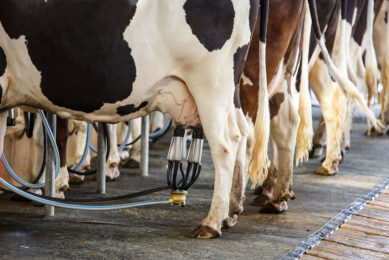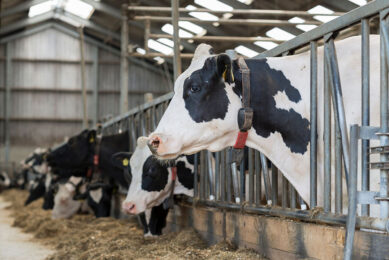Trace minerals in dairy ration: Why source matters

When it comes to ingredients in the dairy ration, how much does the source really matter? Research conducted by Trouw Nutrition, a Nutreco company, finds sulphate sources of trace minerals may harm dairy cows’ physiological performance, reduce NDF digestibility, and negatively impact sustainability. Below, we address concerns associated with the use of sulphate sources of trace minerals in the dairy ration and present trace mineral alternatives such as hydroxychloride sources to help producers avoid the harms posed by sulphate trace minerals.
Essential nutrient stability
Copper, zinc and manganese are essential to a cow’s health, productivity and longevity. These trace minerals impact the cow’s physiological performance including immune competency, hoof integrity and reproduction. But the stability and thus the availability of the trace mineral source differs a lot.

When sulphate trace mineral sources were introduced in the 1940s and 1950s, little research was conducted on how they worked in the animal. As researchers learned more about the consequences of sulphate trace mineral use in the ration, organic sources of trace minerals were developed in the 1970s and 1980s. While the organic sources improved on some problems associated with sulphate trace minerals, they did so at a steep price increase. The introduction of hydroxychloride trace minerals in the 1990s provided an effective and economical approach to feeding essential trace minerals.
Hydroxychloride trace minerals deliver efficacy equivalent to – and potentially better – than organics but at a more attractive price point. Engineered with a crystalline structure and tight covalent bonds, hydroxychloride trace minerals are less soluble and less reactive than sulphate trace minerals.
Trace mineral innovation timeline.

Rumen stability in the animal
An ingredient’s reactivity affects how the mineral behaves with ingredients in the rumen, such as vitamins and probiotics. Sulphate trace minerals are highly unstable chemical entities and as they come into contact with antagonists in the rumen, their high level of reactivity presents several concerns.
Research has shown that highly reactive sulphate trace mineral sources can inflict a significant oxidative effect in the animal, degrading or diminishing expensive vitamin sources in the feed, such as vitamins A, E and D. And while the antimicrobial effects of sulphate trace minerals make them effective at killing pathogens in footbaths, these same properties can destroy beneficial microbes in the rumen and the ration – such as live yeast and various probiotics.
Figure 1 – Findings from 10 studies conducted by Trouw Nutrition.

Impact on NDFD and economics
Findings from 10 studies conducted by Trouw Nutrition demonstrated sulphate sources of copper and zinc had a negative effect on fibre digestibility (Figure 1). Data from these studies indicate a decline of approximately three points of NDFD when zinc and copper sulphates are included in the dairy ration. A paper published by Michigan State University (Oba and Allen, 1999) suggests the economic impact of such a decrease in NDFD is equivalent to about a quarter of a kilo of milk production per cow per day based on 4% milkfat. Applying this estimate to the Trouw Nutrition research suggests an economic cost of about € 0.30 per cow per day when sulphates are included in the ration.
While some feed ingredient buyers may justify the use of sulphates in the dairy ration based on the low price point, the data suggests the cost of reduced performance on the production process should also be taken into account when making trace mineral decisions.
Absorption by the animal
For any trace mineral to deliver its intended value, the metal contained within the trace mineral must make it into the animal’s bloodstream. But simply adding an ingredient to the ration does not necessarily mean the ingredient makes it into the bloodstream. Because the bonds in sulphate trace minerals are weak, the metals contained within the minerals can easily bind with antagonists in the feed before the animal’s system even has a chance to metabolise them. The end result is less metal originating from sulphate trace minerals is available for absorption in the bloodstream. In contrast, hydroxychloride trace minerals’ tight covalent bonds and low solubility help protect the mineral from breaking down in the rumen, allowing more metal to be available for absorption within the animal’s bloodstream.

Sustainability and precision nutrition
As governments and responsible companies seek to support sustainability initiatives, many regions have established lower thresholds for the use of various minerals. These regulations aim to keep various minerals – copper and phosphorus, for example – out of the environment.
Unfortunately, trace mineral absorption is not necessarily efficient in ruminants. Because sulphate trace minerals are not efficiently absorbed, they can be more easily excreted into the environment than hydroxychloride minerals. With an eye toward precision nutrition, hydroxychloride trace minerals were engineered to accurately and adequately meet the cow’s biological requirement. By delivering the precise amount of minerals required, the true physiological requirements of the cow can be accurately met and less of the mineral is excreted into the environment. This approach delivers the least amount of product required to meet biological requirements, maximising absorption of the product in the animal, and minimising destruction of other nutrients in the feed. Ultimately, hydroxy trace minerals increase the efficiency of inputs invested in the animal.
A good example is phytate, the natural source of phosphorous existing within plants. Because of their weak ionic bonds, sulphate trace minerals can easily breakdown, tying up phytate and making it no longer biologically available to the animal. At the same time, phosphorous – a highly regulated element – can be released, presenting a sustainability concern. In contrast, hydroxychloride minerals trace minerals do not tie up phosphorous and allow it to be absorbed versus excreted by the animal.
4 trends driving gut health in 2019
Meeting growing demand for animal protein is a top priority across the production chain. Beyond achieving animal health and performance goals, producers must address bans on antibiotics and threats such as Salmonella and mycotoxins. Find out more…
Avoiding the dangers
Of course, the benefits of any investment in improved nutrition and performance must be weighed against the associated cost. Organic sources of trace minerals have been around for many years and do not inflict the harm associated with sulphate trace minerals. However, organics typically have a high price point, meaning the benefits may not exceed the cost. From both an economic and performance perspective, hydroxychloride trace minerals provide an attractive alternative to organics, allowing farmers to avoid the harmful effects of sulphate trace minerals at a significantly lower price point than organics. Farmers can replace all of their sulphate trace minerals with hydroxychloride trace minerals or replace sulphate trace minerals with a blend of organic and hydroxychloride trace minerals. The most critical factor is to remove sulphate trace minerals – and the harm they cause – from the dairy ration. A conversation with a nutritionist is a good place to start.
For more insights on research related to the harm sulphate trace minerals present, check out a recent FeedChat podcast episode with Dairy Global editor Zana van Dijk
References available upon request.
Join 13,000+ subscribers
Subscribe to our newsletter to stay updated about all the need-to-know content in the dairy sector, two times a week.










